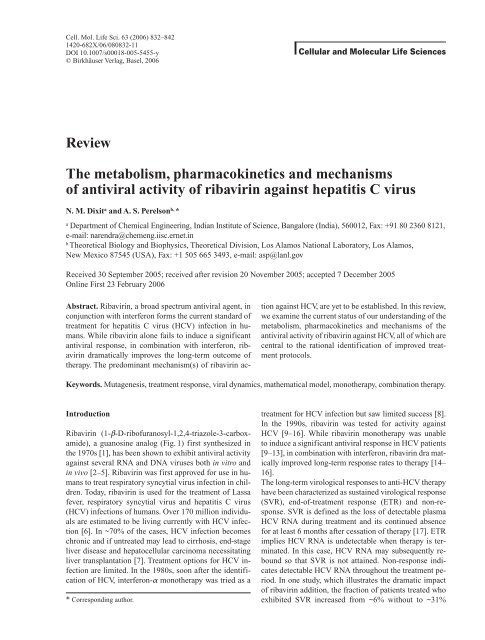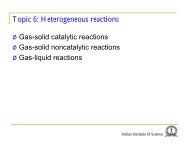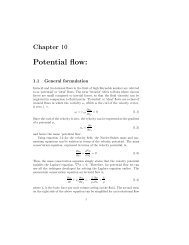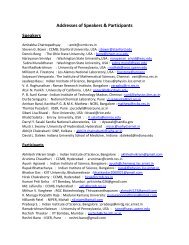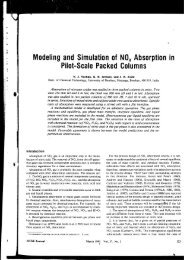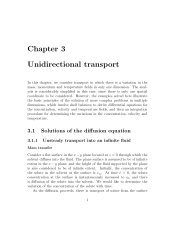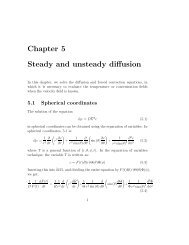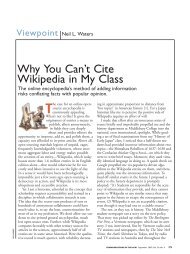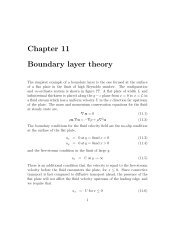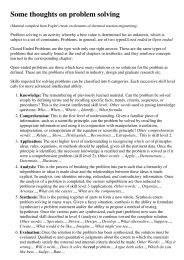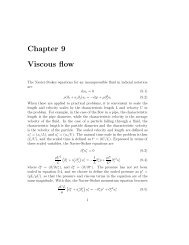Review The metabolism, pharmacokinetics and mechanisms of ...
Review The metabolism, pharmacokinetics and mechanisms of ...
Review The metabolism, pharmacokinetics and mechanisms of ...
Create successful ePaper yourself
Turn your PDF publications into a flip-book with our unique Google optimized e-Paper software.
Cell. Mol. Life Sci. 63 (2006) 832–8421420-682X/06/080832-11DOI 10.1007/s00018-005-5455-y© Birkhäuser Verlag, Basel, 2006Cellular <strong>and</strong> Molecular Life Sciences<strong>Review</strong><strong>The</strong> <strong>metabolism</strong>, <strong>pharmacokinetics</strong> <strong>and</strong> <strong>mechanisms</strong><strong>of</strong> antiviral activity <strong>of</strong> ribavirin against hepatitis C virusN. M. Dixit a <strong>and</strong> A. S. Perelson b, *aDepartment <strong>of</strong> Chemical Engineering, Indian Institute <strong>of</strong> Science, Bangalore (India), 560012, Fax: +91 80 2360 8121,e-mail: narendra@chemeng.iisc.ernet.inb<strong>The</strong>oretical Biology <strong>and</strong> Biophysics, <strong>The</strong>oretical Division, Los Alamos National Laboratory, Los Alamos,New Mexico 87545 (USA), Fax: +1 505 665 3493, e-mail: asp@lanl.govReceived 30 September 2005; received after revision 20 November 2005; accepted 7 December 2005Online First 23 February 2006Abstract. Ribavirin, a broad spectrum antiviral agent, inconjunction with interferon forms the current st<strong>and</strong>ard <strong>of</strong>treatment for hepatitis C virus (HCV) infection in humans.While ribavirin alone fails to induce a significantantiviral response, in combination with interferon, ribavirindramatically improves the long-term outcome <strong>of</strong>therapy. <strong>The</strong> predominant mechanism(s) <strong>of</strong> ribavirin ac-tion against HCV, are yet to be established. In this review,we examine the current status <strong>of</strong> our underst<strong>and</strong>ing <strong>of</strong> the<strong>metabolism</strong>, <strong>pharmacokinetics</strong> <strong>and</strong> <strong>mechanisms</strong> <strong>of</strong> theantiviral activity <strong>of</strong> ribavirin against HCV, all <strong>of</strong> which arecentral to the rational identification <strong>of</strong> improved treatmentprotocols.Keywords. Mutagenesis, treatment response, viral dynamics, mathematical model, monotherapy, combination therapy.IntroductionRibavirin (1-b-D-rib<strong>of</strong>uranosyl-1,2,4-triazole-3-carboxamide),a guanosine analog (Fig. 1) first synthesized inthe 1970s [1], has been shown to exhibit antiviral activityagainst several RNA <strong>and</strong> DNA viruses both in vitro <strong>and</strong>in vivo [2–5]. Ribavirin was first approved for use in humansto treat respiratory syncytial virus infection in children.Today, ribavirin is used for the treatment <strong>of</strong> Lassafever, respiratory syncytial virus <strong>and</strong> hepatitis C virus(HCV) infections <strong>of</strong> humans. Over 170 million individualsare estimated to be living currently with HCV infection[6]. In ~70% <strong>of</strong> the cases, HCV infection becomeschronic <strong>and</strong> if untreated may lead to cirrhosis, end-stageliver disease <strong>and</strong> hepatocellular carcinoma necessitatingliver transplantation [7]. Treatment options for HCV infectionare limited. In the 1980s, soon after the identification<strong>of</strong> HCV, interferon-a monotherapy was tried as a* Corresponding author.treatment for HCV infection but saw limited success [8].In the 1990s, ribavirin was tested for activity againstHCV [9–16]. While ribavirin monotherapy was unableto induce a significant antiviral response in HCV patients[9–13], in combination with interferon, ribavirin dra maticallyimproved long-term response rates to therapy [14–16].<strong>The</strong> long-term virological responses to anti-HCV therapyhave been characterized as sustained virological response(SVR), end-<strong>of</strong>-treatment response (ETR) <strong>and</strong> non-response.SVR is defined as the loss <strong>of</strong> detectable plasmaHCV RNA during treatment <strong>and</strong> its continued absencefor at least 6 months after cessation <strong>of</strong> therapy [17]. ETRimplies HCV RNA is undetectable when therapy is terminated.In this case, HCV RNA may subsequently reboundso that SVR is not attained. Non-response indicatesdetectable HCV RNA throughout the treatment period.In one study, which illustrates the dramatic impact<strong>of</strong> ribavirin addition, the fraction <strong>of</strong> patients treated whoexhibited SVR increased from ~6% without to ~31%
Cell. Mol. Life Sci. Vol. 63, 2006 <strong>Review</strong> Article 833(a)NN NRiboseOwith ribavirin following 24 weeks <strong>of</strong> st<strong>and</strong>ard interferontherapy [14]. Following 48 weeks <strong>of</strong> interferon therapy,SVR increased from ~13% without to ~38% with ribavirin[14]. With pegylated interferon, which has betterpharmacokinetic properties than st<strong>and</strong>ard interferon, responserates improved further [18–20]. For instance, following48 weeks <strong>of</strong> therapy, SVR increased from ~29%without to ~56% with ribavirin [20].No alternative therapies exist for nonresponders [21, 22].Development <strong>of</strong> new anti-HCV drugs has been severelyimpeded by the lack <strong>of</strong> small animal models <strong>and</strong> efficientculture systems, <strong>and</strong> concern over the inherent ability <strong>of</strong>HCV to rapidly acquire antiviral drug resistance mutations[21, 22]. Consequently, combination therapy withpegylated interferon <strong>and</strong> ribavirin has become the currentst<strong>and</strong>ard <strong>of</strong> treatment for HCV infection [18]. At the sametime, significant efforts are under way to identify bettertreatment strategies that would improve long-term responserates [21–23]. <strong>The</strong> substantial improvements intreatment response rates induced by ribavirin suggest,promisingly, that tuning ribavirin therapy may improveresponse rates further. Maintenance therapy with ribavirinis already being assessed as an option for nonresponders[24].Rational therapy optimization hinges on a fundamentalunderst<strong>and</strong>ing <strong>of</strong> the antiviral role <strong>of</strong> ribavirin. Remarkably,despite the widespread use <strong>of</strong> ribavirin over the pastdecade, the predominant mechanism(s) <strong>of</strong> action <strong>of</strong> ribavirinare yet to be established [9, 25, 26]. <strong>The</strong> pharmacokineticpr<strong>of</strong>ile <strong>of</strong> ribavirin has a long terminal eliminationphase, which remains poorly understood [27]. <strong>The</strong>cause(s) <strong>of</strong> the synergy between interferon <strong>and</strong> ribavirin,which appears crucial in anti-HCV therapy [28], remainunclear. Notwithst<strong>and</strong>ing, the promise <strong>of</strong> improving therapyfor HCV infection has rekindled interest in ribavirin.Recent studies have made significant advances, unravelingvarious aspects <strong>of</strong> the effects <strong>of</strong> ribavirin on viralpathogenesis <strong>and</strong> treatment response. In this review, weexamine the current status <strong>of</strong> our underst<strong>and</strong>ing <strong>of</strong> ribavirin<strong>and</strong> its role in the treatment <strong>of</strong> HCV infection.Mechanisms <strong>of</strong> actionNH 2HCV is a hepatotropic flavivirus with a single linear positivestr<strong>and</strong> RNA genome <strong>of</strong> ~10 4 nucleotides. <strong>The</strong> mainNON NRiboseNHNH 2Figure 1. <strong>The</strong> chemical structures <strong>of</strong> ribavirin (a) <strong>and</strong> guanosine (b).(b)target <strong>of</strong> HCV is the hepatocyte. <strong>The</strong> HCV lifecycle remainsto be fully elucidated; most <strong>of</strong> the present underst<strong>and</strong>ingis from replicon systems <strong>and</strong> related viruses [see29–31]. HCV replication proceeds entirely in the cytoplasmin association with cytoplasmic membranes. Followingentry into hepatocytes, the positive str<strong>and</strong> RNAgenome is translated into viral proteins that include theRNA-dependent RNA polymerase (RdRp) central to thereplication process. RdRp employs the RNA genome as atemplate to form negative str<strong>and</strong> RNA intermediates,which in turn facilitate the formation <strong>of</strong> progeny positivestr<strong>and</strong> RNA genomes. <strong>The</strong> latter genomes are packagedinto new viral particles <strong>and</strong> released from infected hepatocytesinto circulation.HCV is a noncytopathic virus. Each infected hepatocytemay therefore give rise to a large number <strong>of</strong> progeny virionsduring its lifetime. Interferon is thought to act as anantiviral agent against HCV by inhibiting viral productionfrom infected hepatocytes [17, 32]. It does this indirectlyby inducing a large number <strong>of</strong> host cell genes thatestablish a non-specific antiviral state within an infectedhepatocyte that may affect viral protein synthesis <strong>and</strong> viralRNA stability [17]. In addition, interferon may actagainst HCV via its effects on the immune system, viz.,promotion <strong>of</strong> memory T-cell proliferation, natural killer(NK) cell activation, dendritic cell maturation <strong>and</strong> inhibition<strong>of</strong> T-cell apoptosis [17]. <strong>The</strong> result is a dramatic reductionin plasma HCV RNA following the onset <strong>of</strong> interferontherapy, which culminates in SVR in a smallfraction <strong>of</strong> the patients treated [33].Several <strong>mechanisms</strong> have been suggested for the broadspectrum antiviral activity <strong>of</strong> ribavirin, viz., direct inhibition<strong>of</strong> viral RNA replication, inhibition <strong>of</strong> the enzymeinosine-monophospate-dehydrogenase (IMPDH), immunomodulation,<strong>and</strong> mutagenesis [17, 25, 26, 34]. <strong>The</strong>se<strong>mechanisms</strong> are illustrated in Fig. 2. Ribavirin has alsobeen suggested to act synergistically with interferon [35,36]. Experimental evidence suggests that different combinations<strong>of</strong> these <strong>mechanisms</strong> may be at play against differentviruses. Here, we summarize available evidence foreach <strong>of</strong> these possible <strong>mechanisms</strong>.Direct inhibition <strong>of</strong> RNA replicationRibavirin is phosphorylated inside cells to ribavirinmono-, di- <strong>and</strong> triphosphate (RMP, RDP <strong>and</strong> RTP, respectively)[37]. RTP, a guanosine triphosphate (GTP)analog, is incorporated into replicating RNA str<strong>and</strong>s byviral RNA polymerases [37–40]. This erroneous incorporationmay inhibit chain elongation <strong>and</strong>, in the extremesituation, cause chain termination. Crotty et al. [38]showed that ribavirin was incorporated in nascent poliovirusstr<strong>and</strong>s without causing chain termination <strong>and</strong>that ribavirin paired equally efficiently with both cytidine<strong>and</strong> uridine. However, cytidine <strong>and</strong> uridine incorporation
834 N. M. Dixit <strong>and</strong> A. S. Perelson Ribavirin in hepatitis C virus infectionIMPGTPIMPDH2RibavirinCTLCTLCTLHCV RNARdRp1RMPRDPT h 1 T h 23RibavirinHepatocyteRTP4Defective HCVFigure 2. Proposed <strong>mechanisms</strong> for the antiviral activity <strong>of</strong> ribavirin against HCV: (1) direct inhibition <strong>of</strong> HCV replication, (2) inhibition<strong>of</strong> the enzyme IMPDH leading to GTP depletion, which in turn may lower viral production <strong>and</strong>/or facilitate greater incorporation <strong>of</strong> RTPin replicating RNA str<strong>and</strong>s <strong>and</strong> hence enhance mutagenesis, (3) immunomodulation via a T h 2 to T h 1 shift in the immune response <strong>and</strong> (4)mutagenesis leading to defective progeny virions. T h , T helper cells; CTL, cytotoxic T cell; RdRp, RNA-dependent RNA polymerase.opposite ribavirin was found to be ~50000% faster thanribavirin incorporation opposite cytidine <strong>and</strong> uridine.RTP has also been shown to be incorporated into replicatingHCV RNA str<strong>and</strong>s, significantly inhibiting chainelongation [40]. Similarly, ribavirin has been found toweakly inhibit the activity <strong>of</strong> many viral polymerases[41–48]. With HCV, however, ribavirin concentrations inthe range 40–150 mM, which are much higher than clinicallyachieved concentrations (~9 mM) [27], were requiredto observe the inhibition <strong>of</strong> polymerase activity[25, 40, 46–48]. Thus, the direct inhibition <strong>of</strong> viral polymeraseactivity by ribavirin is expected to have only a minorantiviral effect against HCV in vivo.A second line <strong>of</strong> reasoning also suggests a limited anti-HCV role for the direct inhibition <strong>of</strong> viral replication byribavirin. Following the onset <strong>of</strong> interferon therapy, arapid first phase decline <strong>of</strong> plasma HCV RNA is observedfor ~1–2 days [32] (Fig. 3). This decline is attributedto a reduction in production <strong>and</strong>/or release <strong>of</strong> newvirions from infected cells due to interferon action [32].Thus, if ribavirin were to inhibit viral replication, a similardecline in plasma HCV RNA would be expected followingthe onset <strong>of</strong> ribavirin therapy. Indeed, Pawlotsky etal. have recently observed that ribavirin does induce aninitial viral load decline in a fraction <strong>of</strong> patients treated[49]. <strong>The</strong> magnitude <strong>of</strong> the decline, however, is significantlysmaller than that induced by interferon. Interferoncan induce a decline <strong>of</strong> several orders <strong>of</strong> magnitude (logs)[32, 49–51]. Ribavirin, in contrast, induced only ~0.5 logdecline in HCV RNA, <strong>and</strong> this decline was transient; viralloads resurged to pretreatment levels in ~4 days [49].<strong>The</strong> origins <strong>of</strong> this resurgence remain unclear. In addi-HCV RNA (copies/ml)10 7 First phase10 6Second phase10 50 5 10 15 20 25t (days)Figure 3. Typical two-phase pr<strong>of</strong>ile <strong>of</strong> plasma HCV RNA declinein patients following the onset <strong>of</strong> interferon therapy.
Cell. Mol. Life Sci. Vol. 63, 2006 <strong>Review</strong> Article 835tion, ribavirin is observed not to enhance the first phasedecline in combination with interferon even when interferoneffectiveness is sub-maximal [49–51]. Thus, only aminor role – if any at all – may be attributed to a direct antiviralaction <strong>of</strong> ribavirin, such as inhibition <strong>of</strong> viral polymeraseactivity.Inhibition <strong>of</strong> IMPDHRMP can cause a depletion <strong>of</strong> intracellular GTP pools bycompetitively inhibiting the host enzyme IMPDH essentialfor the de novo synthesis <strong>of</strong> GTP [25, 52–57]. GTPdepletion may influence viral replication in two ways.First, it may inhibit viral replication because <strong>of</strong> a lack <strong>of</strong>an adequate supply <strong>of</strong> GTP required for RNA synthesis.Second, it may promote the incorporation <strong>of</strong> RTP in place<strong>of</strong> GTP <strong>and</strong> thus increase the error rate during replication,contributing to the mutagenic activity <strong>of</strong> ribavirin (see below).Whether either <strong>of</strong> these pathways significantly contributesto the antiviral activity <strong>of</strong> ribavirin remains unclear.Ribavirin <strong>and</strong> other inhibitors <strong>of</strong> IMPDH, viz., mycophenolicacid <strong>and</strong> VX-497, inhibit HCV replication inthe replicon system [17, 58, 59]. However, whereas addition<strong>of</strong> excess guanosine fully restores HCV replicationrates with mycophenolic acid <strong>and</strong> VX-497, replicationrates are only partially restored with ribavirin [48, 58,59]. Thus, <strong>mechanisms</strong> other than the depletion <strong>of</strong> GTPvia IMPDH inhibition appear to contribute to the antiviralactivity <strong>of</strong> ribavirin. Perhaps, even with an adequatesupply <strong>of</strong> GTP, incorporation <strong>of</strong> RTP in nascent RNAstr<strong>and</strong>s may occur <strong>and</strong> induce mutagenesis.ImmunomodulationSeveral studies have suggested that ribavirin has immunomodulatoryeffects [17, 25, 51], such as the abilityto induce a T h 2 to T h 1 shift in the immune response [60–62]. A T h 1 bias implies a stronger cellular rather than antibodyresponse against infection. Indeed, stronger HCVspecificT cell responses have been observed in patientsunder combination therapy than in patients under interferonmonotherapy [63], but this could be an effect <strong>of</strong> reducingviral load rather than an indication that ribavirinworks via immunomodulation.Ribavirin monotherapy does not lead to SVR [9–13]. Incombination with interferon, ribavirin does improve SVRsignificantly over that with interferon monotherapy [14–16]. <strong>The</strong>se observations suggest synergistic interactionsbetween interferon <strong>and</strong> ribavirin. However, evidence <strong>of</strong>immunomodulation by ribavirin acting synergisticallywith interferon is lacking.Loss <strong>of</strong> infected cells by immune-mediated killing isthought to underlie the second phase decline in HCVRNA (Fig. 3) in patients undergoing interferon-basedtherapy [32, 50, 51]. In some studies, ribavirin is observedto enhance this second phase decline [49, 51].Hermann et al. have recently observed a third phase insome patients, starting somewhere between days 7 <strong>and</strong> 28from the onset <strong>of</strong> therapy, in which HCV RNA decline isfaster than in the second phase [51]. <strong>The</strong> third phase declinewas faster in patients under combination therapythan under interferon monotherapy. Hermann et al. attributethis phase to a better restoration <strong>of</strong> the host immuneresponse in the presence <strong>of</strong> ribavirin. Enhancementin T cell responses leading to a greater loss <strong>of</strong> infectedcells is expected to increase HCV RNA decline in the secondphase (<strong>and</strong> third phase if present) independent <strong>of</strong> interferoneffectiveness. If ribavirin <strong>and</strong> interferon actedsynergistically, as suggested above, then the enhancementin the second phase decline would increase with interferoneffectiveness. In contrast, recent experimental observationssuggest that the addition <strong>of</strong> ribavirin enhancesthe second phase slope but only when interferon effectivenessis low [28, 50, 51]. Thus, greater evidence is requiredto establish an antiviral role <strong>of</strong> ribavirin inducedimmunomodulation.MutagenesisRNA viruses typically exist as a quasispecies – a collection<strong>of</strong> related but not identical genomes – due to theirhighly error prone replication <strong>mechanisms</strong> [64]. <strong>The</strong> existence<strong>of</strong> a quasispecies may provide the necessary diversityto the viruses <strong>and</strong> facilitate escape from specifichost-immune responses <strong>and</strong> drug therapy. However, if theerror rate during replication crosses a threshold, the quasispeciesmay be driven into an error catastrophe, resultingin a meltdown <strong>of</strong> genetic information [65–67]. Ribavirinis known to increase the error rate during viralreplication by being incorporated in place <strong>of</strong> guanosine innascent viral RNA str<strong>and</strong>s [38, 39, 68]. Thus, ribavirinmay potentially drive viruses to extinction by inducing anerror catastrophe. Even if the increase in the mutation ratecaused by ribavirin is inadequate to trigger a completemeltdown <strong>of</strong> genetic information, a higher mutation ratemay render an increasing fraction <strong>of</strong> progeny virions defectiveby compromising their ability to infect new cells<strong>and</strong>/or replicate.Several recent studies lend support to mutagenesis as thekey mechanism <strong>of</strong> the antiviral activity <strong>of</strong> ribavirin [39,68–74]. Crotty et al. have shown that mutagenesis canaccount for the entire antiviral activity <strong>of</strong> ribavirinagainst poliovirus [39]. Poliovirus lost more than 70% <strong>of</strong>its infectivity in one round <strong>of</strong> infection in vitro in thepresence <strong>of</strong> 100 mM ribavirin, which increased the mutationrate from ~1.5 mutations/genome (wild type) to~1.9 mutations/genome [39]. Higher doses causedgreater mutation; at 400 mM ribavirin the mutation frequencyincreased to ~6.9 mutations/genome <strong>and</strong> at1000 mM to ~15.5 mutations/genome [39]. A 9.7-fold in-
838 N. M. Dixit <strong>and</strong> A. S. Perelson Ribavirin in hepatitis C virus infectionsecond phase decline, however, is enhanced by ribavirinin some cases but not in others [49–51]. Nonetheless, asmentioned above, a dramatic improvement in the longtermresponse rates over interferon monotherapy resultsfrom the addition <strong>of</strong> ribavirin [14–20].Dixit et al. [28] have recently developed a mathematicalmodel that quantitatively explains many <strong>of</strong> the effects <strong>of</strong>ribavirin on HCV RNA decline <strong>and</strong> long-term responserates in combination therapy with interferon. <strong>The</strong> modelassumes that ribavirin renders a fraction <strong>of</strong> replicatingvirions non-infectious. Whether this is due to mutagenesisor otherwise does not alter model predictions. <strong>The</strong> followingequations describe viral load evolution undercombination therapy.dI= bTV(1)1 −dIdtdV1= ( 1−Ç)( 1− e)pI −cV(2)1dtdVNI= Ç( 1− e)pI −cVNI(3)dtHere, infectious HCV virions, V I , infect target cells, T, atrate bTV I to form productively infected cells, I, which inthe absence <strong>of</strong> therapy release new virions at rate p per cell.Interferon lowers p by a factor (1 – e), where e is the effectiveness<strong>of</strong> interferon. Of the virions released, ribavirin rendersa fraction Ç non-infectious, giving rise to the populationV NI . Ç is the effectiveness <strong>of</strong> ribavirin. Productively infectedcells die at rate d, <strong>and</strong> free virions are cleared fromplasma at rate c. <strong>The</strong> total viral load is the sum V=V I + V NI .<strong>The</strong> model predicts that ribavirin does not influence thefirst phase <strong>of</strong> viral load decline, but enhances the secondphase decline in a dose-dependent manner provided interferoneffectiveness, e, is low (Fig. 5a). When e is high,ribavirin does not influence the second phase decline either(Fig. 5b). <strong>The</strong>se predictions are in agreement withexperiments [49–51] <strong>and</strong> resolve the confounding observationthat ribavirin influences the second phase declinein some cases but not in others. Model predictions quantitativelycapture experimental HCV RNA changes in patientsunder interferon monotherapy <strong>and</strong> combinationtherapy [50]. Best-fit parameter estimates suggest thatribavirin enhances the second phase slope not by increasingthe death rate, d, <strong>of</strong> infected cells, but by diminishingtheir formation rate by lowering viral infectivity,which is again in contrast to the immunomodulatoryrole <strong>of</strong> ribavirin [28]. Using the distribution <strong>of</strong> d acrosspatients obtained by fitting patient data, the model allowscalculation <strong>of</strong> the fraction <strong>of</strong> patients in whomplasma HCV RNA drops below detection (100 copies/ml) is fully eliminated (i.e., reaches less than one copy inthe 15 l <strong>of</strong> fluid volume in the typical 70 kg patient) duringthe course <strong>of</strong> therapy <strong>and</strong> thus the fraction <strong>of</strong> patientsthat exhibit ETR or SVR, respectively. Model predictionsquantitatively explain the observed ETR <strong>and</strong> SVRrates to interferon monotherapy <strong>and</strong> combination therapy(see, e.g., Fig. 6). With this predictive ability, the modelmay be applied to assess the outcomes <strong>of</strong> altered dosages,treatment patterns <strong>and</strong> durations, <strong>and</strong> thereby identifyoptimal treatment protocols. <strong>The</strong> model thus presentsa framework for rational therapy optimization.ab10 610 6HCV RNA (copies/ml)10 510 410 3ρ = 00.51HCV RNA (copies/ml)10 510 410 3ρ = 010 210 7 0 10 20 30 40 50 60ε = 0.510 210 7 0 10 20 30 40 50 60ε = 0.951t (days)t (days)Figure 5. Calculations with the mathematical model <strong>of</strong> Dixit et al. [28] illustrating the effects <strong>of</strong> ribavirin on HCV RNA decline in combinationtherapy with interferon. (a) When interferon effectiveness is small, ribavirin enhances the second phase decline in a dose-dependentmanner. (b) When interferon effectiveness is high, ribavirin has negligible influence on both the first <strong>and</strong> the second phases. Here, eis the effectiveness <strong>of</strong> interferon, <strong>and</strong> Ç is the effectiveness <strong>of</strong> ribavirin.
840 N. M. Dixit <strong>and</strong> A. S. Perelson Ribavirin in hepatitis C virus infection16 Poynard T., Marcellin P., Lee S. S., Niederau C., Minuk G. S.<strong>and</strong> Ideo G. (1998) R<strong>and</strong>omized trial <strong>of</strong> interferon a2b plus ribavirinfor 48 weeks or for 24 weeks versus interferon a2b plusplacebo for 48 weeks for treatment <strong>of</strong> chronic infection withhepatitis C virus. Lancet 352: 1426–143217 Feld J. J. <strong>and</strong> Ho<strong>of</strong>nagle J. H. (2005) Mechanism <strong>of</strong> action <strong>of</strong> interferon<strong>and</strong> ribavirin in treatment <strong>of</strong> hepatitis C. Nature 436:967–97218 National Institutes <strong>of</strong> Health. (2002) Consensus Statement onManagement <strong>of</strong> Hepatitis C. NIH Consens. State Sci. Statements19: 1–4619 Manns M. P., McHutchison J. G., Gordon S. C., Rustgi V. K.,Shiffman M. Reindollar R. et al. (2001) Peginterferon a-2bplus ribavirin compared with interferon a-2b plus ribavirin forinitial treatment <strong>of</strong> chronic hepatitis C: a r<strong>and</strong>omised trial.Lancet 358: 958–96520 Fried M. W., Shiffman M. L., Reddy K. R., Smith C., MarinosG., Goncales F. L. Jr. et al. (2002) Peginterferon a-2a plus ribavirinfor chronic hepatitis C virus infection. N. Engl. J. Med.347: 975–98221 Tan S.-L., Pause A., Shi Y. <strong>and</strong> Sonenberg N. (2002) HepatitisC therapeutics: Current status <strong>and</strong> emerging strategies. Nat.Rev. Drug Discov. 1: 867–88122 De Francesco R. <strong>and</strong> Migliaccio G. (2005) Challenges <strong>and</strong> successesin developing new therapies for hepatitis C. Nature 436:953–96023 Houghton M. <strong>and</strong> Abrignani S. (2005) Prospects for a vaccineagainst the hepatitis C virus. Nature 436: 961–96624 Ho<strong>of</strong>nagle J. H., Ghany M. G., Kleiner D. E., Doo E., Heller T.,Promrat K. et al. (2003) Maintenance therapy with ribavirin inpatients with chronic hepatitis C who fail to respond to combinationtherapy with interferon alfa <strong>and</strong> ribavirin. Hepatology38: 66–74.25 Lau J. Y. N., Tam R. C., Liang T. J. <strong>and</strong> Hong Z. (2002) Mechanism<strong>of</strong> action <strong>of</strong> ribavirin in the combination treatment <strong>of</strong>chronic HCV infection. Hepatology 35: 1002–100926 Parker W. B. (2005) Metabolism <strong>and</strong> antiviral activity <strong>of</strong> ribavirin.Virus Res. 107: 165–17127 Glue P. (1999) <strong>The</strong> clinical pharmacology <strong>of</strong> ribavirin. Semin.Liv. Dis. 19: 17–2428 Dixit N. M., Layden-Almer J. E., Layden T. J. <strong>and</strong> Perelson A.S. (2004) Modelling how ribavirin improves interferon responserates in hepatitis C virus infection. Nature 432: 922–92429 Bartenschlager R. (2002) Hepatitis C virus replicons: potentialrole for drug development. Nat. Rev. Drug. Discov. 1: 911–91630 Chisari F. V. (2005) Unscrambling hepatitis C virus-host interactions.Nature 436: 930–932.31 Lindenbach B. D. <strong>and</strong> Rice C. M. (2005) Unravelling hepatitis Cvirus replication from genome to function. Nature 436: 933–93832 Neumann A. U., Lam N. P., Dahari H., Gretch D. R., Wiley T.E., Layden T. J. et al. (1998) Hepatitis C viral dynamics in vivo<strong>and</strong> the antiviral efficacy <strong>of</strong> interferon-a therapy. Science 282:103–10733 Lau D. T., Kleiner D. E., Ghany M. G., Park Y., Schmid P. <strong>and</strong>Ho<strong>of</strong>nagle J. H. (1998) 10-Year follow-up after interferon-alphatherapy for chronic hepatitis C. Hepatology 28: 1121–112734 Smith R. A. (1980) Mechanisms <strong>of</strong> action <strong>of</strong> ribavirin. In: Ribavirin:A Broad Spectrum Antiviral Agent, pp. 99–118, SmithR. A. <strong>and</strong> Kirkpatrick W. (eds.), Academic Press, London35 Zhang Y., Jamaluddin M., Wang S., Tian B., Gar<strong>of</strong>alo R. P. <strong>and</strong>Casola A. (2003) Ribavirin treatment up-regulates antiviralgene expression via the interferon-stimulated response elementin respiratory syncytial virus-infected epithelial cells. J. Virol.77: 5933–594736 Buckwold V. E., Wei J., Wenzel-Mathers M. <strong>and</strong> Russell J. (2003)Synergistic in vitro interactions between alpha interferon <strong>and</strong> ribavirinagainst bovine viral diarrhea virus <strong>and</strong> yellow fever virusas surrogate models <strong>of</strong> hepatitis C virus replication. Antimicrob.Agents Chemother. 47: 2293–2298.37 Smith R. A. (1984) Background <strong>and</strong> <strong>mechanisms</strong> <strong>of</strong> action <strong>of</strong>ribavirin. In: Clinical Applications <strong>of</strong> Ribavirin, pp. 1–18,Smith R. A., Knight V. <strong>and</strong> Smith J. A. D. (eds.), AcademicPress, Florida38 Crotty S., Maag D., Arnold J. J., Zhong W., Lau J. Y., Hong Z.et al. (2000) <strong>The</strong> broad-spectrum antiviral ribonucleoside ribavirinis an RNA virus mutagen. Nat. Med. 6: 1375–137939 Crotty S., Cameron C. E. <strong>and</strong> Andino R. (2001) RNA virus errorcatastrophe: direct molecular test by using ribavirin. Proc.Natl Acad. Sci. USA 98: 6895–690040 Maag D., Castro C., Hong Z. <strong>and</strong> Cameron C. E. (2001) HepatitisC virus RNA-dependent RNA polymerase (NS5B) as amediator <strong>of</strong> the antiviral activity <strong>of</strong> ribavirin. J. Biol. Chem.276: 46094–4609841 Eriksson B., Helgstr<strong>and</strong> E., Johansson N. G., Larsson A., MisiornyA., Noren J. O. et al. (1977) Inhibition <strong>of</strong> influenza virusribonucleic acid polymerase by ribavirin triphosphate. Antimicrob.Agents Chemother. 11: 946–95142 Wray S. K., Gilbert B. E. <strong>and</strong> Knight V. (1985) Effect <strong>of</strong> ribavirintriphosphate on primer generation <strong>and</strong> elongation duringinfluenza virus transcription in vitro. Antiviral Res. 5: 39–4843 Toltzis P., O’Connell K. <strong>and</strong> Patterson J. L. (1988) Effect <strong>of</strong>phosphorylated ribavirin on vesicular stomatitis virus transcription.Antimicrob. Agents Chemother. 32: 492–49744 Fern<strong>and</strong>ez-Larsson R., O’Connell K., Koumans E. <strong>and</strong> PattersonJ. L. (1989) Molecular analysis <strong>of</strong> the inhibitory effect <strong>of</strong>phosphorylated ribavirin on the vesicular stomatitis virus invitro polymerase reaction. Antimicrob. Agents Chemother. 33:1668–167345 Rankin Jr. J. T., Eppes S. B., Antczak J. B. <strong>and</strong> Joklik W. K.(1989) Studies on the mechanism <strong>of</strong> the antiviral activity <strong>of</strong> ribavirinagainst reovirus, Virology 168: 147–15846 Bougie I. <strong>and</strong> Bisaillon M. (2003) Initial binding <strong>of</strong> the broadspectrumantiviral nucleoside ribavirin to the hepatitis C virusRNA polymerase. J. Biol. Chem. 278: 52471–5247847 Vo N. V., Young K. C. <strong>and</strong> Lai M. M. C. (2003) Mutagenic <strong>and</strong>inhibitory effects <strong>of</strong> ribavirin on hepatitis C virus RNA polymerase.Biochemistry 42: 10462–1047148 Laxton C., Gilbert S., Sully R., Smith K., Thornberry A.,Wilkinson T. et al. (2000) Characterization <strong>of</strong> interferon-alfa-2a<strong>and</strong> pegylated interferon-alfa-2a in combination with ribavirin,mycophenolic acid or VX-497 as inhibitors <strong>of</strong> HCV repliconreplication. (Abstract) 7th International Meeting on Hepatitis<strong>and</strong> Related Viruses, pp. 33849 Pawlotsky J. M., Dahari H., Neumann A. U., Hezode C., GermanidisG., Lonjon I. et al. (2004) Antiviral action <strong>of</strong> ribavirinin chronic hepatitis C. Gastroenterology 126: 703–71450 Layden-Almer J. E., Ribeiro R. M., Wiley T., Perelson A. S. <strong>and</strong>Layden T. J. (2003) Viral dynamics <strong>and</strong> response differences inHCV-infected African American <strong>and</strong> white patients treated withIFN <strong>and</strong> ribavirin. Hepatology 37: 1343–135051 Herrmann E., Lee J.-H., Marison G., Modi M. <strong>and</strong> Zeuzem S.(2003) Effect <strong>of</strong> ribavirin on hepatitis C viral kinetics in patientstreated with pegylated interferon. Hepatology 37: 1351–135852 Sintchak M. D. <strong>and</strong> Nimmesgern E. (2000) <strong>The</strong> structure <strong>of</strong> insosine5¢-monophosphate dehydrogenase <strong>and</strong> the design <strong>of</strong>novel inhibitors. Immunopharmacology 47: 163–18453 Lowe J. K., Brox L. <strong>and</strong> Henderson J. F. (1977) Consequences<strong>of</strong> inhibition <strong>of</strong> guanine nucleotide synthesis by mycophenolicacid <strong>and</strong> virazole. Cancer Res. 37: 736–74354 Muller W. E. G., Maidh<strong>of</strong> A., Taschner H. <strong>and</strong> Zahn R. K.(1977) Virazole (1-b-D-rib<strong>of</strong>uranosyl-1, 2,4-triazole-3-carboxamide):a cytostatic agent. Biochem. Pharmacol. 26: 1071–107555 Zimmerman T. P. <strong>and</strong> Deeprose R. D. (1978) Metabolism <strong>of</strong> 5-amino-1-b-D-rib<strong>of</strong>uranosyl-imidazole-4-carboxamide <strong>and</strong> relatedfive-membered heterocycles to 5¢-triphosphates in humanblood <strong>and</strong> L5178Y cells. Biochem. Pharmacol. 27: 709–716
Cell. Mol. Life Sci. Vol. 63, 2006 <strong>Review</strong> Article 84156 Balzarini J., Lee C. K., Herdewijn P. <strong>and</strong> De Clercq E. (1991)Mechanism <strong>of</strong> the potentiating effect <strong>of</strong> ribavirin on the activity<strong>of</strong> 2¢,3¢-dideoxyinosine against human immunodeficiencyvirus. J. Biol. Chem. 266: 21509–2151457 Balzarini J., Karlsson A., Wang L., Bohman C., Horska K.,Votruba I. et al. (1993) EICAR (5-ethynyl-1-b-D-rib<strong>of</strong>uranosylimidazole-4-carboxamide):a novel potent inhibitor <strong>of</strong> inosinatedehydrogenase activity <strong>and</strong> guanylate biosynthesis. J.Biol. Chem. 268: 24591–2459858 Pankiewicz K. W., Lesiak-Watanabe K., Watanabe K. A. <strong>and</strong>Malinowski K. (1999) Novel mycophenolic adenine bis(phosphonate)sas potential immunosuppressants. Curr. Med. Chem.6: 629–634.59 Markl<strong>and</strong> W., McQuaid T. J., Jain J. <strong>and</strong> Kwong A. D. (2000)Broad-spectrum antiviral activity <strong>of</strong> the IMP dehydrogenase inhibitorVX-497: a comparison with ribavirin <strong>and</strong> demonstration<strong>of</strong> antiviral additivity with alpha interferon. Antimicrob. AgentsChemother. 44: 859–86660 Tam R. C., Pai B., Bard J., Lim C., Averett D. R., Phan U. T. etal. (1999) Ribavirin polarizes human T cell responses towardsa type 1 cytokine pr<strong>of</strong>ile. J. Hepatol. 30: 376–38261 Peavy D. L., Powers C. N. <strong>and</strong> Knight V. (1981) Inhibition <strong>of</strong>plaque-forming cell responses in vivo by ribavirin. J. Immunol.126: 861–86462 Edell D., Brice E., Hale K., Edell D. <strong>and</strong> Khoshoo, V. (1998)Reduced long term respiratory morbidity after treatment <strong>of</strong> respiratorysyncytial virus bronchiolits with ribavirin in previouslyhealthy infants: a preliminary report. Pediatric Pulmonol.25: 154–158.63 Cramp M. E., Rossol S., Chokshi S., Carucci P., Williams R.<strong>and</strong> Naoumov N. V. (2000) Hepatitis C virus-specific T-cell reactivityduring interferon <strong>and</strong> ribavirin treatment in chronic hepatitisC. Gastroenterology 118: 346–35564 Domingo E., Escarmis C., Sevilla N., Moya A., Elena S. F.,Quer J. et al. (1996) Basic concepts in RNA virus evolution.FASEB J. 10: 859–86465 Eigen M., McCaskill J. <strong>and</strong> Schuster P. (1989) <strong>The</strong> molecularquasi-species. Adv. Chem. Phys. 75: 149–26366 Eigen M., McCaskill J. <strong>and</strong> Schuster, P. (1988) Molecularquasi-species. J. Phys. Chem. 92: 6881–689167 Eigen M. (2002) Error catastrophe <strong>and</strong> antiviral strategy. Proc.Natl. Acad. Sci. USA 99:13374–1337668 Vignuzzi M., Stone J. K. <strong>and</strong> Andino R. (2005) Ribavirin <strong>and</strong>lethal mutagenesis <strong>of</strong> poliovirus: molecular <strong>mechanisms</strong>, resistance<strong>and</strong> biological implications. Virus Res. 107: 173–18169 Severson W. E., Schmaljohn C. S., Javadian A. <strong>and</strong> Jonsson C.B. (2003) Ribavirin causes error catastrophe during hantaanvirus replication. J. Virol. 77: 481–48870 Lanford R. E., Guerra B., Lee H., Averett D. R., Pfeiffer B.,Chavez D. et al. (2003) Antiviral effect <strong>and</strong> virus-host interactionsin response to alpha interferon, gamma interferon,poly(i)-poly(c), tumor necrosis factor alpha <strong>and</strong> ribavirin in hepatitisC virus subgenomic replicons. J. Virol. 77: 1092–110471 Contreras A. M., Hiasa Y., He W., Terella A., Schmidt E. V. <strong>and</strong>Chung R. T. (2002) Viral RNA mutations are region specific<strong>and</strong> increased by ribavirin in a full-length hepatitis C virusreplication system. J. Virol. 76: 8505–851772 Zhou S., Liu R., Baroudy B. M., Malcolm B. A. <strong>and</strong> Reyes G.R. (2003) <strong>The</strong> effect <strong>of</strong> ribavirin <strong>and</strong> IMPDH inhibitors on hepatitisC virus subgenomic replicon RNA. Virology 310: 333–34273 Airaksinen A., Pariente N., Menendez-Arias L. <strong>and</strong> DomingoE. (2003) Curing <strong>of</strong> foot-<strong>and</strong>-mouth disease virus from persistentlyinfected cells by ribavirin involves enhanced mutagenesis.Virology 311: 339–34974 Lanford R. E., Chavez D., Guerra B., Lau J. Y., Hong Z., BraskyK. M. et al. (2001) Ribavirin induces error-prone replication <strong>of</strong>GB virus B in primary tamarin hepatocytes. J. Virol. 75: 8074–808175 Hong Z. (2003) <strong>The</strong> role <strong>of</strong> ribavirin-induced mutagenesis inHCV therapy: a concept or a fact? Hepatology 38: 807–81076 Young K. C., Lindsay K. L., Lee K. J., Liu W. C., He J. W., MilsteinS. L. et al. (2003) Identification <strong>of</strong> a ribavirin-resistantNS5B mutation <strong>of</strong> hepatitis C virus during ribavirin monotherapy.Hepatology 38: 869–87877 Lutchman G. A., Danehower S., Park Y., Ward C., Liang J. T.,Ho<strong>of</strong>nagle J. H. et al. (2004) Mutation rate <strong>of</strong> hepatitis C virusinpatients during ribavirin montherapy. Hepatology 41:385A78 Asahina Y., Izumi N., Enomoto N., Uchihara M., Kurosaki M.,Onuki Y. et al. (2005) Mutagenic effects <strong>of</strong> ribavirin <strong>and</strong> responseto interferon/ribavirin combination therapy in chronichepatitis C. J. Hepatol. 43: 623–62979 Perelson A. S. <strong>and</strong> Ribeiro R. M. (2005) Mutagenic effects <strong>of</strong>ribavirin in vivo. J. Hepatol. 43: 553–55580 Tsubota A., Akuta N., Suzuki F., Suzuki Y., Someya T.,Kobayashi M. et al. (2002) Viral dynamics <strong>and</strong> <strong>pharmacokinetics</strong>in combined interferon a-2b <strong>and</strong> ribavirin therapy for patientsinfected with hepatitis C virus <strong>of</strong> genotype 1b <strong>and</strong> highpretreatment viral load. Intervirology 45: 33–4281 Arase Y., Ikeda K., Tsubota A., Suzuki F., Suzuki Y., Saitoh S.et al. (2005) Significance <strong>of</strong> serum ribavirin concentration incombination therapy <strong>of</strong> interferon <strong>and</strong> ribavirin for chronic hepatitisC. Intervirology 48: 138–14482 Lindahl K., Stahle L., Bruchfeld A. <strong>and</strong> Schvarz R. (2005)High-dose ribavirin in combination with st<strong>and</strong>ard dose peginterferonfor treatment <strong>of</strong> patients with chronic hepatitis C. Hepatology41: 275–279.83 Catlin D. H., Smith R. A. <strong>and</strong> Sameuls A. I. (1980) 14 C-Ribavirin:distribution <strong>and</strong> pharmacokinetic studies in rats, baboons<strong>and</strong> man. In: Ribavirin: A Broad Spectrum AntiviralAgent, pp. 83–98, Smith R. A. <strong>and</strong> Kirkpatrick W. (eds.), AcademicPress, London84 Glue P., Schenker S., Gupta S., Clement R. P., Zambas D. <strong>and</strong>Salfi M. (2000) <strong>The</strong> single dose <strong>pharmacokinetics</strong> <strong>of</strong> ribavirinin subjects with chronic liver disease. Br. J. Clin. Pharmacol.49: 417–42185 Khakoo S., Glue P., Grellier L., Wells B., Bell A., Dash C. et al.(1998) Ribavirin <strong>and</strong> interferon alfa-2b in chronic hepatitis C:assessment <strong>of</strong> possible pharmacokinetic <strong>and</strong> pharmacodynamicinteractions. Br. J. Clin. Pharmacol. 46: 563–57086 Preston S. L., Drusano G. L., Glue P., Nash J., Gupta S. K. <strong>and</strong>McNamara P. (1999) Pharmacokinetcs <strong>and</strong> absolute bioavailability<strong>of</strong> ribavirin in healthy volunteers as determined by subisotopemethodology. Antimicrobial Agents Chemother. 43:2451–245687 Lin C.-C., Yeh L.-T., Luu T., Lourenco D. <strong>and</strong> Lau J. Y. N.(2003) Pharmacokinetics <strong>and</strong> <strong>metabolism</strong> <strong>of</strong> [ 14 C]ribavirin inrats <strong>and</strong> cynomulgus monkeys. Antimicrobial Agents Chemother.47: 1395–139888 Patil S. D., Ngo L. Y., Glue P. <strong>and</strong> Unadkat J. D. (1998) Intestinalabsorption <strong>of</strong> ribavirin is preferentially mediated by theNa + -nucleoside purine (N1) transporter. Pharm. Res. 15: 950–95289 Jarvis S. J., Thorn J. A. <strong>and</strong> Glue P. (1998) Ribavirin uptake byhuman erythrocytes <strong>and</strong> the involvement <strong>of</strong> nitrobenzylthioinosine-sensetive(es)-nucleoside transporters. Br. J. Clin. Pharmacol.123: 1587–159290 Galois-Montbrun S., Chen Y., Dutartre H., Sophys M., MoreraS., Guerreiro C. et al. (2003) Structural analysis <strong>of</strong> the activation<strong>of</strong> ribavirin analogs by NDP kinase: comparison with otherribavirin targets. Mol. Pharmacol. 63: 538–54691 Page T. <strong>and</strong> Connor J. D. (1990) <strong>The</strong> <strong>metabolism</strong> <strong>of</strong> ribavirin inerythrocytes <strong>and</strong> nucleated cells. Int. J. Biochem. 22: 379–38392 Shulman N. R. (1984) Assessment <strong>of</strong> hematological effects<strong>of</strong> ribavirin in humans. In: Clinical Applications <strong>of</strong> Ribavirin,Smith R. A., Knight V. <strong>and</strong> Smith J. A. D. (eds.) pp. 79–92, AcademicPress, New York
842 N. M. Dixit <strong>and</strong> A. S. Perelson Ribavirin in hepatitis C virus infection93 Welling P. G. (1986) Pharmacokinetics: Processes <strong>and</strong> Mathematics,American Chemical Society, Washington, DC94 Gabrielson J. <strong>and</strong> Weiner D. (2000) Pharmacokinetic <strong>and</strong> PharmacodynamicData Analysis: Concepts <strong>and</strong> Applications,Swedish Pharmaceutical Press, Stockholm95 Powers K. A., Dixit N. M., Ribeiro R. M., Golia P., Talal A. H.<strong>and</strong> Perelson A. S. (2003) Modeling viral <strong>and</strong> drug kinetics: hepatitisC virus treatment with pegylated interferon a-2b. Semin.Liv. Dis. 23: 13–1896 Smith R. A. <strong>and</strong> Kirkpatrick W. (1980) Ribavirin: A BroadSpectrum Antiviral Agent, Academic Press, London97 Ribeiro R. M., Layden-Almer J., Powers K. A., Layden T. J. <strong>and</strong>Perelson A. S. (2003) Dynamics <strong>of</strong> alanine aminotransferaseduring hepatitis C virus treatment. Hepatology 38: 509–517


